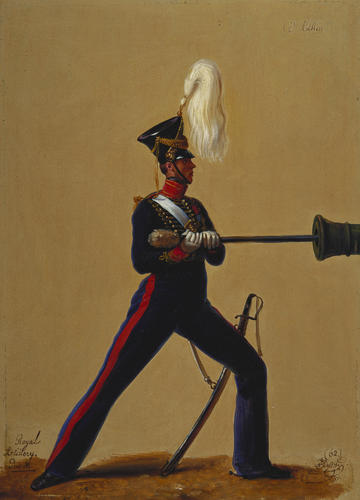-
1 of 253523 objects
Gunner James Aitken (b. 1804), Royal Horse Artillery Signed and dated 1832
Oil on card | 34.95 x 25.4 x 0.25 cm (support, canvas/panel/stretcher external) | RCIN 407071

Alexandre-Jean Dubois Drahonet (1791-1834)
Gunner James Aitken (b. 1804), Royal Horse Artillery Signed and dated 1832
-
In 1832 French portraitist Alexandre-Jean Dubois Drahonet was commissioned by William IV to paint one hundred pictures illustrating the uniform of the British Army. The Royal Collection retains most of this series. A photograph of the Equerry’s Room at Windsor Castle taken in around 1900 shows some of these paintings hanging together, framed in groups.
During the period of peace following the Napoleonic Wars, increasingly elaborate (and often quite impractical) military attire was devised, particularly by George IV. By the time William IV came to the throne in 1830, uniforms had become too expensive and were simplified and adapted once again. The result of these changes was codified and promulgated in the 1831 Dress Regulations. These paintings were intended to provide a visual record of the recent changes to military dress. Their value is not only historical, however, but also aesthetic: Drahonet produces lively, slightly elongated figures, capturing their facial expressions and setting them in a variety of organic poses.Each painting in the series depicts a single figure against a neutral background. Although their uniform and accoutrements are the focus, the sitters are often identified by name, as well as regiment and rank. Shown here is Gunner James Aitken of the Royal Horse Artillery. The Royal Horse Artillery were mounted troops founded in 1793 to provide mobile fire support to the cavalry regiments. A Gunner was the artillery equivalent of a Private.
Aitken is depicted wearing the hybrid cavalry-artillery uniform seen in 407073, although without the chevrons of rank on his sleeve. Drahonet depicts him in action, pushing a ramrod into a gun barrel to load either the charge or the shot. The other end of the ramrod was equipped with a sponge, as can be seen here, which was used to extinguish any burning material left in the barrel after firing.
Provenance
Commissioned by William IV; recorded in the Equerries Room at Windsor Castle in 1878
-
Creator(s)
-
Medium and techniques
Oil on card
Measurements
34.95 x 25.4 x 0.25 cm (support, canvas/panel/stretcher external)
Category
Object type(s)
Other number(s)
JSS 49